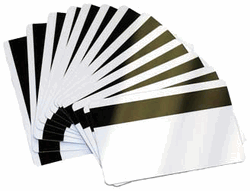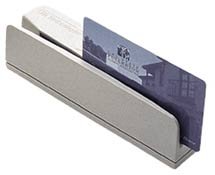|
Help & Information
|
|
| Magnetic Stripe Cards
|
| _ |
|
 |
 |
Self-Service
Encoding
With DistinctID.com, you can order custom encoded magnetic stripe cards.
We provide 1/2" HICO magnetic stripe cards and our online card designer
allows you to store data on any of the 3 tracks. To ensure highest
compatibility with standard badge readers, the designer validates the data you
enter according to the ISO standards mentioned below. Since track one only
allows upper-case characters, the designer will automatically convert lower
case characters to upper-case. We will automatically add the start sentinel,
end sentinel, and LRC characters to each track. Use of the field separator
character is optional. Within the ISO guidelines for each track, you can define
and encode up to 217 bytes of information per card as necessary for your
custom application.
|
Due to its low cost and reliability, magnetic stripe
technology is well known and continues to be a dominant card technology in the
United States. Magnetic stripe cards are typically used for:
-
Credit and bank cards
-
Debit cards
-
Transit tickets (bus and subway fares)
-
Airline tickets and boarding passes
-
Prepaid (stored) value cards, and
-
Access control cards.
Magnetic stripe recording is very similar to audio and
video recording. The basic differences, of course, are that the magnetic
material is applied to a paper or plastic card or ticket and data is stored on
the stripe instead of sound or images. Information can be recorded, read, and
re-recorded many times. Instead of motors moving the tape so it can be read,
your hand provides the motion as you "swipe" a card through a reader.
Data is recorded in "tracks" in much the same way sound is recorded on audio
casettes. Multiple tracks are available on each stripe and multiple stripes may
be used on a card or ticket to increase data capacity. There are three track
locations on a standard credit or ATM card.
Although financial transaction cards are the best known application, there are
many other uses for magnetic stripe cards and tickets including video games and
key access. Track locations and data format for these applications do not
necessarily follow the same standards as do financial cards.
In the past, magnetic stripe materials could be damaged by powerful
refrigerator magnets and other common sources of magnetic fields. Today,
however, high coercivity (HiCo) magnetic stripe media is virtually immune to
inadvertent magnetic damage (although using a magnet to put your credit card on
the refrigerator is still a bad idea). Magnetic stripe readers are "blind" as
to whether a stripe is HiCo or LoCo and are designed to read both. A badge encoder
is needed to write data on a magnetic stripe and not all encoders support
writing to HiCo media. HiCo encoders are usually more expensive because
the encoding requires more power.
ISO Magnetic Stripe Encoding
Standards have been established by the International
Standards Organization for
-
Materials (of stripe and cards),
-
Stripe locations (on cards and tickets),
-
Track locations (on stripe), and
-
Data encodation methods.
There are three tracks on the magnetic stripe. Each track is .110-inch wide.
The ISO/IEC standard 7811, which is used by banks, specifies:
-
Track one: Up to 76
alpha-numeric characters plus start sentinel, end sentinel, and
Longitudinal Redundancy Check (LRC) characters. The encoding for track one
is 7 bits at 210 bits per inch allowing 64 different characters:
<space> ! " # $ % & ' ( ) * + , - . / 0 1 2 3 4 5 6 7 8 9 : ; < =
> ? @ A B C D E F G H I J K L M N O P Q R S T U V W X Y Z [ \ ] ^
_ The start sentinel is "%", the end sentinel is "?", and the
field separator character for track one is "^".
-
Track two: Up to 37 numeric-only characters plus start
sentinel, end sentinel, and Longitudinal Redundancy Check (LRC) characters. The
encoding for track two is 5 bits at 75 bits per inch allowing 16 different
characters: 0 1 2 3 4 5 6 7 8 9 : ; < = > ? The start sentinel is
";", the end sentinel is "?", and the field separator character for
track two is "=".
-
Track three: Up to 104 numeric-only characters plus start
sentinel, end sentinel, and Longitudinal Redundancy Check (LRC) characters. The
encoding for track one is 5 bits at 210 bits per inch allowing 16 different
characters: 0 1 2 3 4 5 6 7 8 9 : ; < = > ? The start sentinel is
";", the end sentinel is "?", and the field separator character for
track three is "= ".
Badge Reader Notes:
-
Although most badge readers sold in the USA are ISO compatible, not
all support reading all 3 tracks on the magnetic stripe. In fact, readers
that only read tracks 1 & 2 are common.
-
Badge readers come in many flavors! Adapter configurations may be
built-in and/or added on via separately purchased adapters. Connection options
include RS-232, DB9, USB, USB w/keyboard emulation, PS2 keyboard wedge, and
others. It is recommended that you thoroughly research your options before
purchasing a new reader.
-
Most badge readers can be re-programmed to modify the presentation
of scanned tracks. Please refer to your reader's user manual and/or
manufacturer's web site for technical information and/or utility software
specific for your reader.
-
Non keyboard emulation readers may require special software that
must be installed before an application can receive data from the reader.
Please refer to your reader's documentation and/or visit the manufacturer's
website to obtain technical information for your specific reader model.
|
|
|